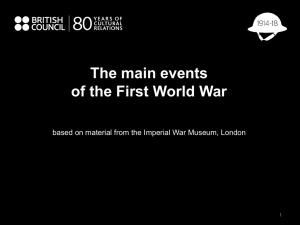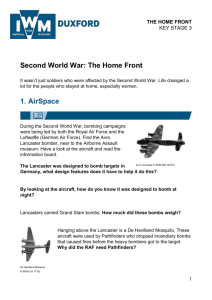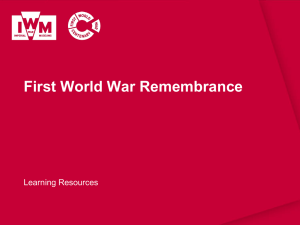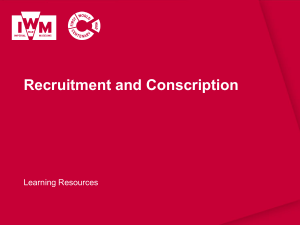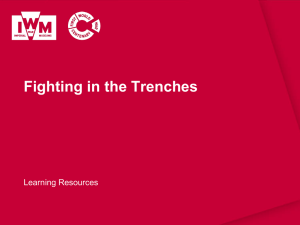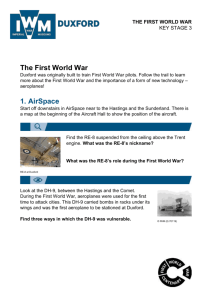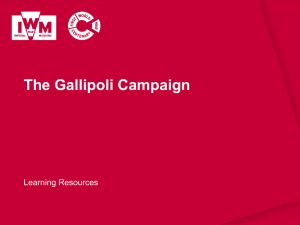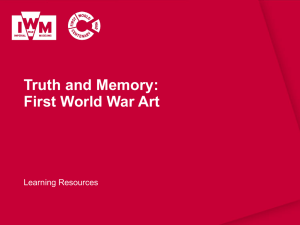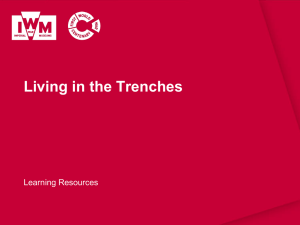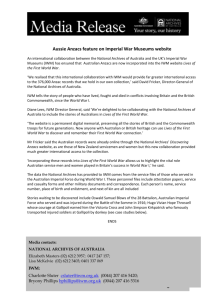Afghanistan: a country in transition
advertisement
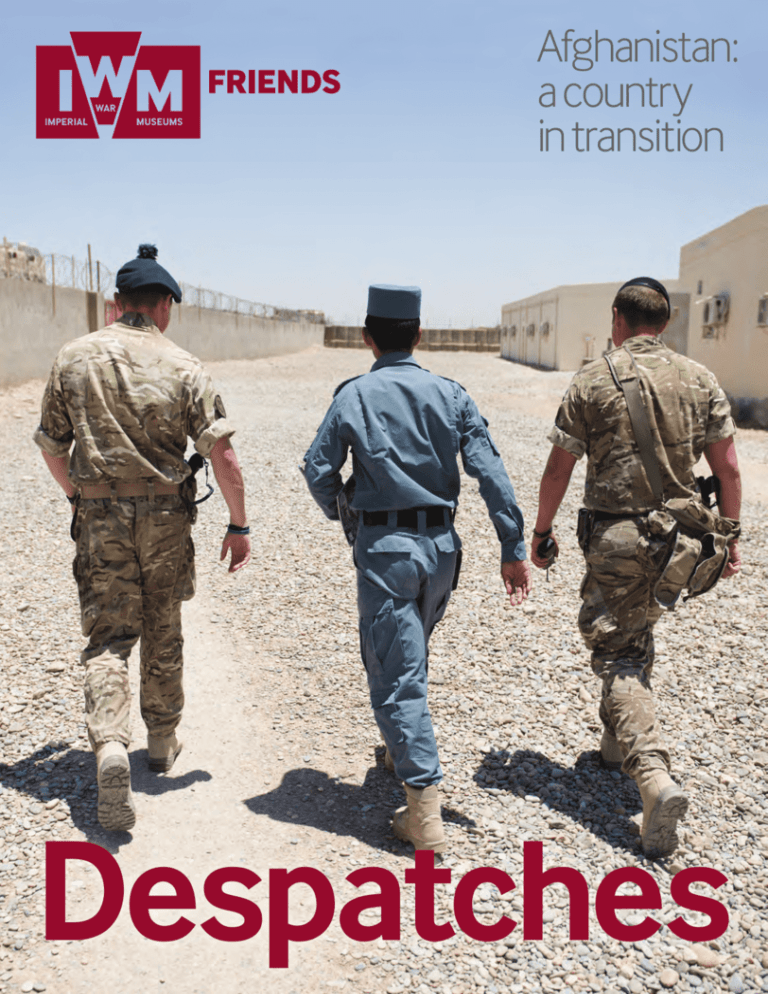
Afghanistan: a country in transition Despatches Below: A British mentor teaches troops of the Afghan National Army (ANA) how to use mortars at Camp Shorabak, Helmand, 2013. IWM DC 2696 IWM DC 3867 Left: View of the outskirts of Kabul, the capital city of Afghanistan, 2014. Afghanistan: a country in transition IWM Historian Matt Brosnan gives an overview of War Story: Afghanistan 2014, a new exhibition at IWM London, with pictures by IWM Photographer Richard Ash. 2 ■ Despatches Winter 2014 The end of 2014 marks the withdrawal of British and international combat troops from Afghanistan after thirteen years of war. While this is a significant step, it does not mean a neat conclusion to the conflict or the end of British and international involvement in the country. Instead it represents a transition, as Afghanistan takes more control of its own affairs. The future of the country is delicately poised, with uncertainty over Afghanistan’s continued stability. The latest War Story display – the third in a series exploring British experiences in Afghanistan and the nature of the conflict – provides a snapshot of Afghanistan at this transitional point. The war in Afghanistan began in 2001, following the 11 September attacks on the USA carried out by al-Qaeda terrorists. The initial aims were to target al-Qaeda and remove the extreme Islamist Taliban regime in Afghanistan that harboured them. Both of these were achieved in a rapid military campaign by coalition troops, predominantly from the USA and Britain. However, expanded NATO (North Atlantic Treaty Organisation) involvement in the conflict meant a longer-term commitment to Afghanistan and soon after the regime was removed, Taliban insurgents began to regenerate. From 2006 to 2012, the war increased in violence. For British troops stationed in Helmand Province in the south of the country, many of the places they served – Sangin, Musa Qala, Now Zad, Nad Ali, Lashkar Gah – became bywords for intense fighting. For British troops on the ground, this often involved patrolling areas threatened by Taliban fighters who could seemingly melt in and out of their surroundings, as well as encountering the hidden dangers of improvised explosive devices (IEDs). Since the beginning of the conflict over 450 British service personnel have died in Afghanistan, the majority killed during this intense period. ➜ Winter 2014 Despatches ■ 3 IB 2798C CECIL BEATON Cadets of the Chinese National Revolutionary Army parade at the Central Military Academy, Chengtu, Szechuan, China, 1944. THEATRE OF WAR ‘This war, as far as I can see, is something specifically designed to show up my inadequacy in every possible capacity. It’s doubtful if I’d be much good at camouflage – in any case my repeated requests to join have been met with, “You’ll be called if you’re wanted.” What else can I do?’ Cecil Beaton, September 1939 Cecil Beaton (1904-1980) was a British designer, writer, cartoonist, diarist and socialite who loved theatre in all its forms. However, he is best remembered as the leading British portrait and fashion photographer of his day. Beaton’s glamorous, elaborately staged photographs of royalty and twentieth century celebrities reflected his theatrical tastes and were published in magazines, newspapers and books throughout the world. The fact that he was one of Britain’s hardest working war photographers during the Second World War is less well known. As an official photographer for the British Ministry of Information, Beaton travelled far and wide to document the impact of war on people and places in his own unique style. In later life, Beaton came to regard his war photographs as his single most important body of photographic work. The eldest child of a prosperous timber merchant, Cecil Beaton had a comfortable childhood which was firmly rooted in the Edwardian era. Socially and professionally ambitious, his abilities as a photographer, artist, designer and writer were evident from an early age. Beaton himself attributed the origins of his interest in photography and the theatre to a ➜ 4 ■ Despatches Summer 2012 A 12612 Sir Cecil Beaton is best remembered as a portrait and fashion photographer, but during the Second World War he was one of Britain’s hardest working war photographers. Hilary Roberts previews a new exhibition at IWM London which looks at the work he produced as an official photographer for the Ministry of Information. A Maintenance Wren models the new WRNS official issue boiler suit and turban, Portsmouth, 1942. Summer 2012 Despatches ■ 5 IWM CONTEMPORARY MIKE MOORE LEE CRAKER The dome of Shahid Mosque photographed against a backdrop of oil fires. The fires were lit by Iraqis in an attempt to confuse Coalition bombers. Baghdad, March 2003. Photo: Mike Moore. Curator Hilary Roberts on a new exhibition at IWM London showcasing the work of photographers Mike Moore and Lee Craker. 6 ■ Despatches Winter 2013 MIKE MOORE ©MIRRORPIX / THE DAILY MIRROR. Perspectives on Iraq 1991 – 2011 Winter 2013 Despatches ■ 7 The Imperial War Museum was founded to make sure that we never forget what it is like to live in a world torn apart by conflict. Over the coming months and years, with the First World War Centenary upon us, IWM will be in the spotlight as never before. Our visitors and the media are keenly anticipating what form the galleries will take, what objects we will show and what we will say about them. I know that IWM Friends will be particularly eager to learn what you can expect to find and I would like to take this opportunity to give you an outline of the galleries as well as an insight into some of the thinking behind them. We began working on the galleries over four years ago, when a small team of IWM historians and curators was brought together to see the project through from concept to realisation of the galleries. Our first task was to map out a storyline for them, to give the most devastating conflict in Britain’s history a fresh perspective which has historical integrity and is relevant, engaging and illuminating for all our visitors. Audience research showed that we needed to answer four important questions: Why did the war begin? Why did it continue? How did the Allies win? What was the impact of the war? Save the Wheat and Help the Fleet, Hazell, Watson and Viney Ltd, litho, London, 1917. German U-boats threatened to starve Britain of food and supplies. In accordance with IWM’s remit, we set out to answer these questions from a British and Empire perspective. We were also determined to ensure that the home front story was woven into the narrative. After all, this was a conflict that was fought by whole societies – not just by soldiers, but by the men, women and children at home who supplied and supported them. Over many weeks, we considered what form the story should take. The fruits of our debates and deliberations were translated into the fourteen main Story areas in the new galleries, each of which has a number of Substories. A board of distinguished academic advisers, chaired by IWM Trustee Professor Sir Hew Strachan, helped us to chart our way through some of the more difficult waters as we refined and polished our narrative. When we had agreed upon a framework for the galleries, we began to carry out a trawl of the collections and to plot objects large and small into the spaces. As you know, IWM’s First World War collections are unrivalled in their breadth and depth and the selection process was challenging. We looked at weaponry. We examined uniforms and equipment. We read thousands of letters and diaries. We pored over pamphlets and posters, photographs and works of art. We watched hours of film. Our curatorial teams offered up recommendations and stories to streamline and guide our thinking. The final selection which you will see in the galleries comprises 1,300 items from our collections. They range from military hardware, uniforms and equipment to intensely personal items. Some objects will be familiar to you, many of them not. What they have in common is that they all have powerful stories to tell, not only of destruction and loss, but also of endurance, innovation, courage, duty and devotion. As we looked at the objects, we also had to think about how and what we would say about them. We had to bear in mind that these would be the first galleries at IWM to show events outside living memory, and to consider what that meant for our audiences. When the Imperial War Museum opened in June 1920, King George V declared that the new museum would remember ‘common effort and common sacrifice’. For the first visitors to the new museum, the war was not history but the recent past. The exhibits needed little interpretation because those ➜ Commemorating the First World War 8 ■ Despatches Summer 2014 First World War ‘On War Service’ badge issued by the Ministry of Munitions. IWM INS 7767 Art. IWM PST4470 IWM London’s new First World War Galleries will open to the public on 19 July 2014. James Taylor, IWM’s Head of Research and Information, describes the journey from their inception to completion. Summer 2014 Despatches ■ 9 A lasting impact 14-18 NOW is a major cultural programme taking place across the United Kingdom to mark the centenary of the First World War. During the summer of 2014 it launched its first series of events. 14-18 NOW’s Director, Jenny Waldman, reflects on the programme so far. The aim of 14-18 NOW is to open up discussions about the First World War beyond those individuals who are already interested in that conflict and the ceremonial aspects which surround it. Perceptions of the war have been shaped to a great extent by the artists of the time, including poets, writers, painters, sculptors, photographers and film-makers, many of whom served, and who reflected on the war and its effects. Their work had a profound and lasting impact. So it seemed appropriate to invite contemporary artists from the UK and around the world to explore the resonance of the First World War one hundred years later, as culture and the arts played such an important role in recording and interpreting the extraordinary and devastating events of the war. Working with cultural organisations across England, Wales, Scotland and Northern Ireland, the aim was to commission special projects, selected to encourage people from every community to reflect on how the First World War has shaped today’s world and our attitudes to conflict now. We could not have anticipated such an overwhelmingly positive response or such original and diverse ideas from these artists which revealed both familiar and new stories. Many different forms of expression were represented in the programme, including art, film, performance and poetry. ➜ 1 spectra by Ryoji Ikeda, 2014, view from Primrose Hill by Thierry Bal. Produced and presented by Artangel, co-commissioned by 14-18 NOW and the Mayor of London. 10 ■ Despatches Winter 2014 Winter 2014 Despatches ■ 11 Poems from the Front the poets most likely to be studied by British schoolchildren, they look bemused. I think some of them assume that I’m going to talk about patriotic celebrations of great heroism; or maybe they have in mind something like Tennyson’s ‘Charge of the Light Brigade’. When we come to read Wilfred Owen, Isaac Rosenberg and others, they’re surprised to find that these poems have the power to fire their own imaginations and demand their full attention. Graves said that he wrote his early war poems to show the ‘ignorant’ people back home in Britain what the war was really like. Frustrated by what he read in newspapers (‘rosy official accounts of execrable battles’) and irritated by the unthinking support for the war that he encountered when he went back home on leave, he wanted to shine an ‘unofficial light’ on the horrors he saw in the trenches. His initial response to the war included a rather graphic poem describing ‘A Dead Boche’, Robert Graves though as the war progressed he developed a more personal and thoughtful tone. Wilfred Owen put it a different way, saying that all a poet in his situation could do was ‘to tell the truth and to warn’. Poets like Graves, Owen and Sassoon are sometimes accused of having an undue influence on shaping the way we now view the First World War. It is a commonly-heard lament that schoolchildren seem more inclined to listen to the poets rather than the historians, who in turn argue that the war is more complex and more subtle than the one decried by Siegfried Sassoon, with his mutinous contempt for buffoonish generals. Graves would no doubt be surprised to hear that the poems he and his friends wrote in the heat of battle are still considered problematic with regard to how ‘official’ Britain considers the war in which they fought. But he would also, I think, have some sympathy with Jeremy Paxman, an historian of the war who also loves its poetry, who recently warned that a diet that consisted only of Owen and Sassoon would focus too much on a narrative of horror and pointless sacrifice at the expense of any wider and more balanced interpretation of the conflict. The answer to this is not to stop teaching or reading Sassoon and Owen, but to establish a wider and more balanced view of the poetry written during the war, as well as a greater understanding of the men and women who wrote it. The attitude to the war expressed in the best poetry written at the front is wide-ranging, complex and frequently ambiguous. In other words, it reflects the varied range of experience of a great many of the people who were there. Some of the poets were officers, while others were privates, nurses, medical orderlies and chaplains. They saw the war from very different angles, though there are some common themes in the poems they wrote to describe their experiences. There is, for example, no hatred of the enemy; rather a deep bond of compassion and humanity with others caught up in the war. There is a great yearning for peace, friendship and the consoling beauty of the natural world. David Jones, for example, served as a ➜ Mary Borden, extract from ‘Come to me quickly...’ I am suffocating – I cannot get away – They cling to my skirts, my arms My hands – They clutch at my strength They call my name – They keep calling me. They cry to me to undo their pain and let them free – I cannot set them free. They throw themselves onto my breast, to die – I cannot even let them die – Come to me for one hour, strong, clean – whole – Their wounds gape at me – Their stumps menace me – Their bandaged faces grimace at me Their death rattle curses me – Give me rest – Make me clean – I am stained – I am soiled – I am streaked with their blood – I am soaked with the odor of the oozing of their wounds – I am saturated with the poison of their poor festering wounds – I am poisoned – I’m infected – I shall never wash it off – But you are clean – Your face is cold and fresh and wet by the rain – Let me drink the fresh moisture of your face with my lips – Your garments are electric with the wild blowing wind – Put your gallant cloak about me – Let me breathe, Let me breathe. © Patrick Aylmer IWM Q101780 Siegfried Sassoon 12 ■ Despatches Summer 2014 Professor Paul O’Prey on the poetry of the First World War. COURTESY OF THE ROBERT GRAVES ESTATE Shakespeare and Byron both had to wait over a hundred years before they had a memorial stone in Poets’ Corner, which shows just how remarkable it is that Robert Graves was honoured there while he was still alive. In November 1985, a month before Graves died, the then Poet Laureate, Ted Hughes, unveiled a memorial stone on which is carved the names of sixteen poets who served in the First World War. Graves was among them, along with his friends Siegfried Sassoon, Edmund Blunden and Wilfred Owen. The fact that Westminster Abbey couldn’t wait for the last of them to die before installing the memorial is an indication of how the poetry of the First World War has established a unique hold on our collective imagination. In the words of a more recent Poet Laureate, Andrew Motion, the poetry of the First World War has become an almost sacred national text. When I have lectured about war poetry abroad in places such as China or parts of Europe, students are intrigued by what they tend to see as a uniquely British literary phenomenon. When I tell them that, after Shakespeare, the war poets can be among Mary Borden Summer 2014 Despatches ■ 13 Art and conflict in a media age Curator Sara Bevan gives an insight into a new exhibition at IWM North, showcasing IWM’s contemporary art collection What do artists contribute to our perceptions of war and conflict in a time when our general understanding of conflict is increasingly shaped by the media and the internet? Working outside the pressures of journalism, artists can propose ideas, urging the viewer to think deeply about what war is, about its immediate impact, its long-term repercussions and how we remember it. They invite us to consider our definition of conflict in a time when war no longer has easily-defined geographical limits. Often taking their personal history as a starting point, many artists navigate this broad-ranging subject matter as observers, activists or philosophers. At a time when there is a growing emphasis on the media spectacle and an expectation of immediate access to events as they unfold, our new exhibition Catalyst: Contemporary Art and War takes works from IWM’s unique art collection and explores the rich, varied and moving artistic response to conflict in a media age. COLLECTION IWM © ANNABEL DOVER COLLECTION IWM © STEVE MCQUEEN. PRESENTED BY THE ART FUND Catalyst: Contemporary Art and War is on display until 23 February 2014 at IWM North, The Quays, Trafford Wharf Road, Trafford Park, Manchester M17 1TZ. Open daily (except 24, 25, 26 December) 10am to 6pm (1 March to 31 October) and 10am to 5pm (1 November to 28 February) Opposite page: Photo Op, kennardphillipps, 2007. Above: Queen and Country, Steve McQueen, 2006. Right: Cyanotype [RAF Sock], Annabel Dover, 2010. COLLECTION IWM © KENNARDPHILLIPPS 14 ■ Despatches Winter 2013 Winter 2013 Despatches ■ 15 Support us and enjoy an exclusive pass to all five branches By joining IWM Friends you are giving invaluable support to a range of projects that will help future generations to understand the causes, course and consequences of war. In return you can enjoy: Unlimited free entry to IWM London paying exhibitions including Horrible Histories: Spies (until 4 January 2015) and Fashion on the Ration: 1940s Street Style (from 5 March to 31 August 2015) Free entry to IWM Duxford* Unlimited free entry to Churchill War Rooms Unlimited free entry to HMS Belfast Despatches, the Friends magazine, delivered direct to your door Exclusive Friends events To join or to purchase a gift membership please call us on 020 7416 5255 or visit iwm.org.uk/friends *except special events and Air Show days at IWM Duxford Discounts and free admission are at the discretion of IWM and IWM Trading Company 16 ■ Despatches Winter 2014
